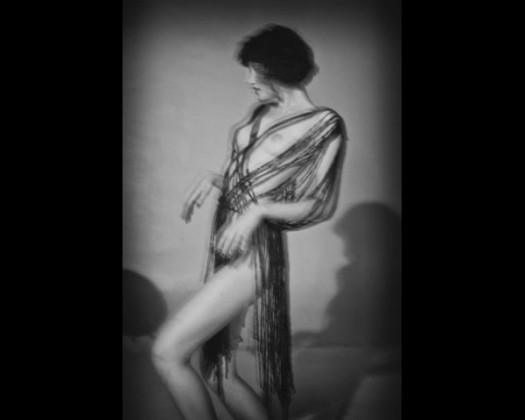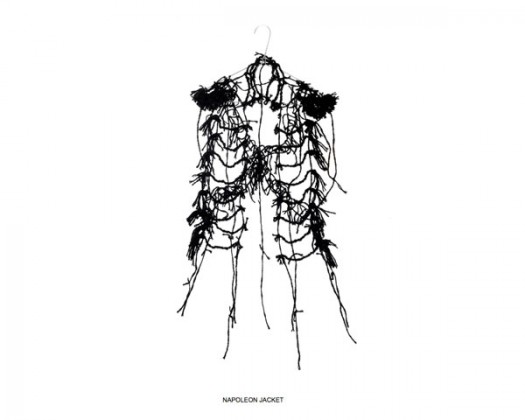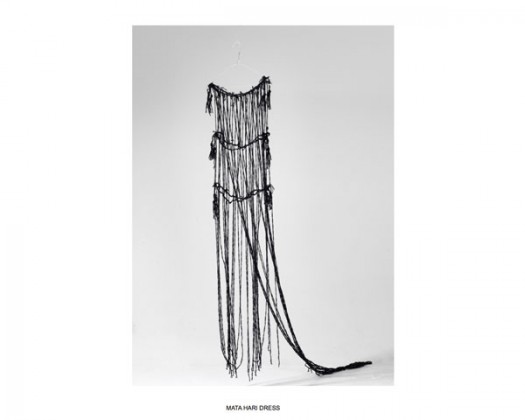December 9th, 2011
A reflection on Absence: Thanos Kyriakides
by Francesca Granata

Blind Adam, Photos by Yiorgos Mavropoulos
Thanos Kyriakides started Blind Adam in 2007, with the intent of
exploring the more poetic and artistic qualities of fashion. His work
consists, for the most part, of creating ghostly exoskeleton of
garments. Rendered in black wool acrylic thread, his pieces are
reminiscent of photographic negatives, thus reading as a meditation on
absence and loss. They also speak to the forgotten craft of
clothes-making, as they carefully follow the place where the seams would
have been, thus reading as a reference to garment construction and
pattern-making. Previously to his work with Blind Adam, Thanos worked
predominantly as a stylist for magazine editorial, where the careful
construction of a perfect vision is paramount. Thus, his current work,
in its very quiet and tactile quality—the thread used to construct the
ghostly garment refer to the Braille system for the blind—seems an
obvious departure from such work.
I met Thanos while in Greece this summer to give a talk about the
grotesque in contemporary fashion, in conjunction with Vassilis
Zidanakis’s exhibition “Arghhh Monsters in Fashion” at the Benaki Museum
in Athens. I was so intrigued by his work that I later checked in with
the artist via e-mail….
You started Blind Adam in 2007. What prompted your transition
from working in editorial and magazines to doing this more experimental
work?
After 17 years in fashion, it was about time for me to find a way to
express more esoteric feelings and go beyond the limits of fashion, in
order to orient myself towards a more artistic direction.

Your work now has as much more to
do with a tactile quality than it does with a visual one, as well as
being very time consuming. Could you describe your process, and the way
in which you construct your pieces?
Yes, that’s true. The process has two stages: it starts by taking
double acrylic wool thread, which is the material I always use, and
making knots along its length. The result is something that is
reminiscent of a chaplet or a “connect the dots” game. After having made
miles of this, I pass onto the construction of a piece by assembling
the hand-knotted threads.

If I understand your work
correctly, you use wool thread to create an exoskeleton of a garment, as
the thread follows the lines of where the garment’s seams would have
been. In some ways, your work reads like the ghost of a garment, where
all the cloth has left and only the silhouette of seams remains. As a
result, your work suggests, at least to me, an absence—the absence of
the body, but also of the cloth, which is meant to represent that body.
Would you agree? This certain feeling of melancholia, past and memory is
perhaps most obvious in your pieces that make references to historical
pieces, such as the jacket with epaulettes.
Exactly! One could say that it is the bare of the bare minimum or a metaphor,
but of course the structural form of the clothes is present in a
ghostly way. This is especially true of the pieces that represent the
garment’s skeletons. There is a strong reference to the “Emperor’s New
Clothes” tale.

I was also wondering why you
chose such a limited palette (of black and white)? Again, perhaps I am
projecting, but your pieces also remind me of shadows.
Yes indeed, a shadowy, ghostly effect was intended. Aside from that, black on
white gives the desirable graphic contrast, reminding of a sketch with black pen on white paper, that becomes 3D.
I was wondering if you could speak about your recent string
installations. Did you mean to create a map of the room? I know your
work often has to do with measuring distance through the use of
equidistant knot on the thread you use. Is the installation a
continuation of this?
The installation is called “Incommunicado” and my intention was to
create a symbolic tower of Babel. The piece was adjusted according to
the room’s dimensions as I intended for the installation to have a
claustrophobic spider-web effect. What I forgot to mention earlier is
that the knotted thread that I use, also refers to the Braille system
for the blind so you could say that it represents a form of language.
The meaning of this piece is that human conversation has a minimum point
of contact and then spreads to undetermined directions until it meets
again for a split second and so on, creating thus a communicating maze.

Finally, I was wondering if a
shift from a medium that is more closely related to image/distance and
vision, such as fashion photography, to one that involves tactility,
making and a more intimate/close connection to the object, is something
that came about as a result in your change in vision? And if so, how?
Yes, it certainly affected this transition but not in a compelling way.
With this project I wanted to combine various influences, references,
ideas, esoteric needs and of course to set questions on fundamental
issues that have been always puzzling humanity.
Also don’ t miss the beautiful film
GHOND from Thanos Kyriakides on Vimeo.
Posted in Exhibitions, Interviews, Textiles |